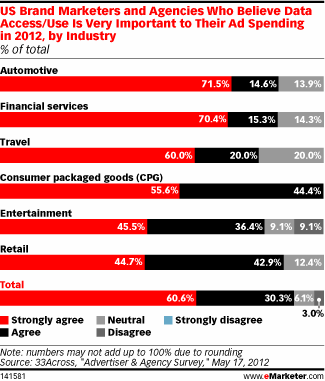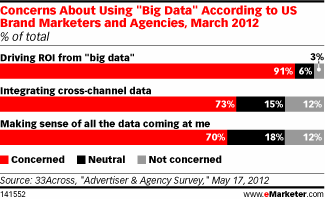By Steve Fowler
One of the luxuries of the new era of service based game marketing is the influx of big data. This can both be a blessing and a curse for some. In previous “Publisher 2.0″ articles, I have discussed how data can sometimes stifle creativity and counter branding efforts if misused. Data can also have a massive positive outcome on a campaign’s effectiveness, and on a marketer’s ability to optimize efforts. Even though it is a scary place, let’s dig into data to better understand the details of dealing with it, and more importantly putting it to work.
In a recent article on eMarketer, different industries were polled as to their reliance on data to drive effective marketing spends.

A key takeaway here is that entertainment is the category that’s greatly lagging behind others when it comes to marketing ad spend decisions. This is primarily driven by the film industry’s reliance on short burst ad spends, and the game industry’s similar approach when it comes to blockbuster console game launches. If we are to be successful in this new emerging service based marketing approach, we better start paying attention to data and have it play a bigger role in determining spending decisions to mitigate the risk of spending inefficiently.

There exists a great anxiety among marketers about how to implement data and what actions should be taken with it. Another eMarketer survey clearly illustrates this point, finding 70 percent of marketers are concerned with data overload.
So how do we reduce this concern and “make sense” of the data, and ultimately have it improve our ROI? One very important step is determining what data points are most important to optimize against and at which part in the marketing cycle. Yet even before this, one of the biggest issues marketers face with a data-driven approach is lack of understanding of which key performance indicators (KPI) to track and set goals against. So let’s go there.
TRACKING
The first step in implementing a data-driven marketing approach is tracking the data. It’s a no brainer but the important part is doing it well. We have seen this done well by only a few among the companies we work with here at Ayzenberg.
I asked Vincent Juarez, Principal, Media Director at Ayzenberg, to give an overview of how to approach tracking for the various paid media sources available to game marketers.
Juarez writes:
Tracking 101
The e-Marketer report cited here suggests that entertainment industry marketers and agencies are less interested in ad campaign related data. Yet a sub-segment of acquisition-based video game marketers are at the forefront of integrating best practices in this area from other industries, implementing proprietary tracking systems and pushing the limits of agency accountability.
The data dependency movement among these game industry marketers is driven by two key factors: the service game/free-to-play /MTX business model explosion, which required agencies to reinvent their approach to be hyper-accountable for client budgets, and the emergence of online as and to a lesser extent mobile as core media vehicles for reaching gamers.
When online media was in its infancy, the key unique selling propositions (USP) were tracking, accountability and optimization. Over the last decade, the medium has for the most part delivered on DR centric USPs while evolving to a legitimate sight/sound/motion branding vehicle. The most sophisticated campaigns incorporate tracking multiple KPIs to profile and retarget consumers based on multi-variant ad exposure, conversion funnel progression, offline/online behavior, monetization and brand perception/purchase intent metrics.
Although the online and mobile industries are evolving to develop third party cookie/SDK tracking alternatives, cookies combined with other proprietary platform based analytic solutions are still the most predominant agency data acquisition tools.
Tracking has also evolved into a double-edged sword (a.k.a. the “agency curse”) as clients often fixate on isolated versus integrated campaign metrics. As a byproduct, clients often hold the ad campaign exponentially more accountable than other elements of the marketing mix and down-play the impact that advertising has on organic growth. Despite technological breakthroughs, online tracking and data acquisition has limitations. It is an “imperfect science,” and the industry is constantly evolving to address everything from tech incompatibility and cookie deletion to anti-tracking legislation and hacking.
Tracking Offline Media
As the service based game industry expands and becomes more lucrative, marketers are increasingly receptive to mainstream “off-platform” vehicles that increase reach, break through the clutter and surround the fragmented gaming consumers through multiple media touch points. The biggest challenge for agencies is that service game marketers tend to be pre-conditioned to track multiple KPIs with online media and therefore expect traditional media to have the same type of accountability.
Offline vehicles such as broadcast, print and outdoor can be tracked in a variety of ways. Solutions include but aren’t limited to dedicated vanity URLs, text-based short-codes, QR codes, specialty tech such as Shazam, vehicle specific offer redemption, and overall KPI lift beyond tracked vehicles. Despite these multiple solutions, none provide the accuracy, accountability and immediacy of online and mobile.
Tracking Tool Primer
A typical online CPA display campaign requires that consumers are tracked from the initial ad impression through a landing page, short multi-step funnel process and resulting mid-funnel registration. Third party ad server tracking code from an IAB approved ad server is often used in conjunction with vendor specific conversion tracking pixels. These validate results and allow ad networks to dynamically optimize and re-target.
In most cases agency or vendor tracking is cookie based. It tracks progression based page-loads or funnel button actions, and can track all the way up to a pre-download registration conversion. Mid-funnel conversion tracking is critical for performance vendors to participate in CPA bounty programs. However, this only provides part of the data required for optimization. Due to browser incompatibility, download tech or other technicalities, end-funnel tracking typically requires the marriage of third party ad servers, appended URL codes from a provider such as Omniture, Google Analytics or equivalent tech.
In an ideal situation, tracking provides full transparency on user behavior for retargeting, frequency capping, multi-variant ad serving, mid-funnel conversions (for vendor CPA bounties) and end funnel monetization (to validate results). However, online tracking for many campaigns is limited based on funnel tech restrictions or client confidentiality prohibiting full transparency, and therefore affecting full monetization.
KPI PRIORITIZATION (A.K.A. SETTING GOALS)
Most marketing stakeholders in the game industry will agree that access to data is a good thing. The more information we have at our fingertips, the better informed our spending decisions will be. That being said, there can be an opposite effect if the right KPIs are not defined. Data is a dangerous drug and can be easily misused. I admit that when I started getting deeply involved in data-driven marketing, my reliance on data to drive every decision made me narrow-minded. All of my focus and attention was placed on driving towards optimizing a specific attribute of my spend, too often at the expense of other efforts. It is very easy to shift into direct marketing as the only consumer communication. That significantly marginalizes the products we are selling.
Before we get into the pitfalls of making decisions based on data alone, we need to look at how to set goals with a data-driven approach. Determining what to set goals against and which data points to pay attention to at which point in the campaign remain critically important.
Here’s how Juarez sees it:
Best practices for planning a service-based game campaign involves creating media phases that align with specific marketing milestones and pillars, integration initiatives and overall product lifecycle. Each phase contains a specific media mix, resulting KPIs and success metrics. Each phase should also be setup as a dynamic feedback loop to validate goals or optimize vehicles, creative variants, budgets, CPA bounties and other KPIs for future phases.
The phased approach results in varying KPI priorities based on how media aligns with the product lifecycle. For example, initial pre-launch phases could prioritize tracking implementation testing early in the product lifecycle to fine tune the funnel for future phases. Subsequent beta phases could prioritize driving the most efficient acquisitions, registrations and pre-launch buzz. Launch could emphasize social media interaction, branding, conversion intent and volume. Post-launch could include accolade-based creative response rates, monetization metrics such as cost per active user (CPAU), average revenue per paid user (ARPPU), and initial data for life-time value (LTV) calculations. As you can see, KPI priority weighting can be a complex process that can vary considerably based on the client and campaign phase. The fundamental approach should be to always provide custom solutions that factor in client goals and tracking limitations.
Goal setting is a collaborative process between client and agency. In an ideal situation, overall marketing goals are provided by the client and refined by the agency through predictive funnel analysis and real-world campaign testing. A constant challenge agencies face is balancing client CPA efficiency goals with real-world volume potential. The $1 CPA goal clients often set are theoretically attainable, however they are not feasible based on real-world volume constraints. Actual results can help determine optimizations for subsequent campaign phases and ensure that expectations are realistic.
A/B TESTING
 World of Warcraft multi-variants
World of Warcraft multi-variants
They say variety is the spice of life. It’s also the key to success in data-driven marketing. We call variety “multi-variants” to sound sophisticated but really, it is a very simple process as long as you plan for it and are ready to react to the results. Prior to big data availability we needed to take educated guesses at variations on messaging, creative, calls to action and offers. Now we can run all of the variations on a campaign simultaneously and optimize against each variable. This process is mostly applied to online advertising such as search or display, but it can be used effectively in other media as well.
With the shift in the game industry from product-focused to service-focused marketing, we enjoy the opportunity to spend more slowly, be highly targeted and test our messages. This is A/B testing. A key benefit of it is that it allows for very effective retargeting later in the marketing cycle.
“A dynamic feedback test loop and persistent funnel testing are key components of a service based game campaign,” adds our media guru Juarez. “Testing can involve multiple funnel and creative variants. A/B creative and funnel tests are the most common, however some campaigns test C/D/E/F variants and beyond. Best creative practices involve testing copy and visuals with significant differentiation to draw meaningful conclusions. In terms of media, it’s key to minimize bias by ensuring that all variants are tested on the same sites or networks at the same time, provided equal rotation, and are exposed to identical market conditions.”
OPTIMIZATION – MAKING SENSE OF THE DATA
Once you have placed the proper tracking and identified the most important data points to pay attention to, now you need to make sense of it, and make actionable decisions based on it. This really is the whole point of it, making optimized decisions from the data retrieved. This is where the “Publisher 2.0″ game marketing rock stars separate themselves from the rest.
It’s this optimization decision-making process that not only makes your spend more efficient but also grows your acquisition, retention and monetization KPI. Let’s say that you have identified that the main goal of your current marketing cycle is to improve monetization. You have placed the proper tracking code, identified the KPIs to watch, set aside the right spend and executed a campaign based on that goal. With proper data tracking, you can group your consumers to evaluate quality of spenders. For instance, say we group consumers by source of acquisition and look at ARPPU based on that data point. With enough data and time you could find something like — on average, consumers acquired via website A monetize 15 percent less than those brought in from website B. This is a powerful data point that can have a dramatic impact on subsequent business decisions.
With this data at hand, you can confidently shift your marketing spend to more profitable media outlets, inform your PR team where the next exclusive story should go, or customize an in-game offer for the better performing sites.
Juarez highlights the pitfalls here, citing what he calls “analysis paralysis.”
“Data based optimization can be a very complex process,” says Juarez. “[It] potentially leads to ‘analysis paralysis’ or fixation on isolated KPIs from a snapshot in time at the risk of maximizing long-term results. In theory, campaigns should be optimized on a site or placement basis using a combination of initial response, mid level registration and end funnel monetization KPIs.”
He adds, “In the short run, vehicles can be optimized or eliminated based on initial results. However, additional factors such as campaign duration, market conditions, competitive activity, integrated marketing efforts, product life-cycle updates, new creative, multiple phases, and monetization volume versus velocity should be factored into the assessment. In the long run, previously eliminated performance network and core gaming vehicles should be reassessed or retested to determine if any change in the marketing mix or market conditions could result in a positive outcome. Additional consideration should also be placed on 30-60 day post-campaign click/view-based conversion and monetization results.”
BALANCING DATA DRIVEN DECISIONS WITH OTHER INPUT
In a previous Publisher 2.0 article, I covered the dangers of relying too heavily on data and metrics when making marketing decisions. The simple fact is that we are marketing games. Gamers are usually driven by emotion, not always by direct response offers. This is not classic packaged goods marketing where we can simply rely on one message to drive a conversion. Gamers, and especially hard core ones, go through a process before making a purchase decision. Data driven marketing efforts in a vacuum will fail.
Here’s what I mean by that – no single marketing tactic should be employed in a silo if you expect results. Marketing is a “surround-your-consumer” activity. Data-driven marketing allows for unprecedented optimization and testing of your ads, but it shouldn’t be an area of singular focus at the expense of other important factors such as branding. Branding efforts in particular seem to be all too frequently abandoned by data driven marketers. This may result in short term effectiveness but rarely results in success in the long run. Branding provides consumer affinity, loyalty and reduces the commoditization of your product. Overall, the best marketing campaigns employ multiple outlets and diverse tactics.
The increase in data availability allows for optimizing campaigns like never before, helping validate messaging or spend or placement. It’s perhaps the most powerful tool we have, yet it’s another bullet in the chamber and not a silver one. Overreliance on direct response data-driven marketing can in-fact backfire, eroding your brand if not used in harmony with other efforts.

